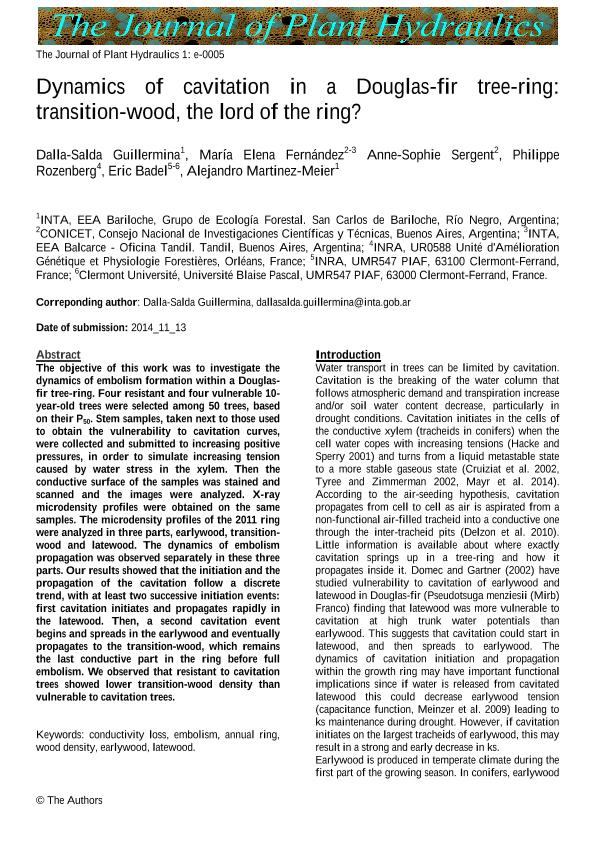Mostrar el registro sencillo del ítem
dc.contributor.author
Dalla Salda, Guillermina

dc.contributor.author
Fernandez, Maria Elena

dc.contributor.author
Sergent, Anne Sophie

dc.contributor.author
Rozenberg, Philippe

dc.contributor.author
Badel, Eric
dc.contributor.author
Martinez Meier, Alejandro Gabriel

dc.date.available
2022-12-07T18:08:45Z
dc.date.issued
2014-11
dc.identifier.citation
Dalla Salda, Guillermina; Fernandez, Maria Elena; Sergent, Anne Sophie; Rozenberg, Philippe; Badel, Eric; et al.; Dynamics of cavitation in a Douglas-fir tree-ring: Transition-wood, the lord of the ring?; Institut National de la Recherche Agronomique; Journal of Plant Hydraulics; 1; 11-2014; 1-5
dc.identifier.issn
2268-4565
dc.identifier.uri
http://hdl.handle.net/11336/180602
dc.description.abstract
The objective of this work was to investigate the dynamics of embolism formation within a Douglasfir tree-ring. Four resistant and four vulnerable 10- year-old trees were selected among 50 trees, based on their P50. Stem samples, taken next to those used to obtain the vulnerability to cavitation curves, were collected and submitted to increasing positive pressures, in order to simulate increasing tension caused by water stress in the xylem. Then the conductive surface of the samples was stained and scanned and the images were analyzed. X-ray microdensity profiles were obtained on the same samples. The microdensity profiles of the 2011 ring were analyzed in three parts, earlywood, transitionwood and latewood. The dynamics of embolism propagation was observed separately in these three parts. Our results showed that the initiation and the propagation of the cavitation follow a discrete trend, with at least two successive initiation events: first cavitation initiates and propagates rapidly in the latewood. Then, a second cavitation event begins and spreads in the earlywood and eventually propagates to the transition-wood, which remains the last conductive part in the ring before full embolism. We observed that resistant to cavitation trees showed lower transition-wood density than vulnerable to cavitation trees.
dc.format
application/pdf
dc.language.iso
eng
dc.publisher
Institut National de la Recherche Agronomique
dc.rights
info:eu-repo/semantics/openAccess
dc.rights.uri
https://creativecommons.org/licenses/by/2.5/ar/
dc.subject
CONDUCTIVITY LOSS
dc.subject
EMBOLISM
dc.subject
ANNUAL RING
dc.subject
WOOD DENSITY
dc.subject
EARLYWOOD
dc.subject
LATEWOOD
dc.subject.classification
Otras Ciencias Biológicas

dc.subject.classification
Ciencias Biológicas

dc.subject.classification
CIENCIAS NATURALES Y EXACTAS

dc.title
Dynamics of cavitation in a Douglas-fir tree-ring: Transition-wood, the lord of the ring?
dc.type
info:eu-repo/semantics/article
dc.type
info:ar-repo/semantics/artículo
dc.type
info:eu-repo/semantics/publishedVersion
dc.date.updated
2022-12-06T17:11:49Z
dc.identifier.eissn
2426-413X
dc.journal.volume
1
dc.journal.pagination
1-5
dc.journal.pais
Francia

dc.journal.ciudad
Clermont Ferrand
dc.description.fil
Fil: Dalla Salda, Guillermina. Instituto Nacional de Tecnología Agropecuaria. Centro Regional Patagonia Norte. Estación Experimental Agropecuaria San Carlos de Bariloche. Grupo de Ecología Forestal; Argentina
dc.description.fil
Fil: Fernandez, Maria Elena. Consejo Nacional de Investigaciones Científicas y Técnicas. Centro Científico Tecnológico Conicet - Patagonia Norte; Argentina. Instituto Nacional de Tecnología Agropecuaria. Centro Regional Buenos Aires Sur. Estación Experimental Agropecuaria Balcarce; Argentina
dc.description.fil
Fil: Sergent, Anne Sophie. Consejo Nacional de Investigaciones Científicas y Técnicas. Centro Científico Tecnológico Conicet - Patagonia Norte; Argentina
dc.description.fil
Fil: Rozenberg, Philippe. Institut National de la Recherche Agronomique; Francia
dc.description.fil
Fil: Badel, Eric. Institut National de la Recherche Agronomique; Francia. Clermont Université; Francia
dc.description.fil
Fil: Martinez Meier, Alejandro Gabriel. Instituto Nacional de Tecnología Agropecuaria. Centro Regional Patagonia Norte. Estación Experimental Agropecuaria San Carlos de Bariloche. Grupo de Ecología Forestal; Argentina
dc.journal.title
Journal of Plant Hydraulics
dc.relation.alternativeid
info:eu-repo/semantics/altIdentifier/url/https://jplanthydro.org/article/view/31
dc.relation.alternativeid
info:eu-repo/semantics/altIdentifier/doi/https://doi.org/10.20870/jph.2014.e005
Archivos asociados
